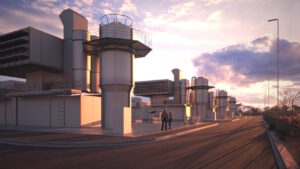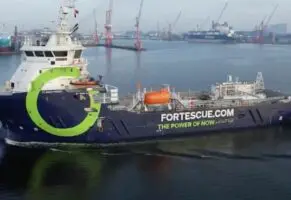Fortescue Future Industries (FFI) will commence negotiations on a potential deal to convert one of Australia’s commercial-scale ammonia production facilities to run on renewable hydrogen, potentially rescuing the plant from closure after a study found the conversion technically feasible.
The FFI study found that converting the Gibson Island ammonia facility, operated in Queensland by Incitec Pivot, to using hydrogen produced from renewable energy sources rather than fossil gas would be possible.
The two companies will now undertake an engineering design study that will detail the expected cost, timing and commercial opportunities of the plant conversion, with a final investment decision expected to follow.
Incitec Pivot said that the Brisbane ammonia facility could ultimately use up to 50,000 tonnes of renewable hydrogen a year to produce more than 300,000 tonnes of green ammonia, with Fortescue constructing and operating an onsite electrolysis plant to supply the facility with renewable hydrogen.
That level of green hydrogen production would require electricity supplies from around 1,000MW of wind and solar capacity. It would allow for a complete replacement of the ammonia plant’s existing fossil hydrogen feedstock.
Last month, Incitec Pivot announced that it planned to cease manufacturing operations at the Gibson Island facility as it was unable to secure an affordable supply of fossil gas. However, the prospect of retrofitting the facility with an onsite green hydrogen supply could provide the facility with a much needed lifeline.
Most of the world’s ammonia production is used as a fertiliser in agricultural production, but it may also be used as a fuel for heavy transport, as well as an effective transport medium for hydrogen.
Ammonia is produced through a process of combining hydrogen with nitrogen, with fossil fuels serving as the traditional source of hydrogen for the process, which results in greenhouse gas emissions as a by-product.
However, the potential for low-cost supplies of hydrogen produced using renewable energy sources creates the potential for ammonia production without the need for fossil fuels and effectively decarbonising the process.
FFI chairman Andrew Forrest said the positive outcome of the technical feasibility study, instigated in October, was a step forward for the decarbonisation of a key Queensland industry.
“The announcement of this important agreement at the IPL site in Brisbane in October was a significant milestone, and I am delighted that we are now ready to confirm that we are moving to the next phase of studies to make this dream a reality,” Forrest said.
Incitec Pivot CEO Jeanne Johns said there would be advantages in being able to convert an established ammonia production facility to operate on renewable energy sources and that the company had adopted a target of reaching zero net emissions by 2050.
“We’re committed to pursuing opportunities to help create a more sustainable world, and our investigation of new and emerging technologies, such as green ammonia, is a key part of this,” Johns said.
“Our world-class ammonia expertise is advancing progress of this exciting project and, working with FFI, we have found it is technically feasible to manufacture green ammonia at an industrial scale at Gibson Island. As an existing brownfield site, this offers many advantages.”
Forrest has previously said that he would lead an ambitious pivot of the Fortescue business from its current focus on iron ore to the production of green materials, including hydrogen, ammonia, and green steel.
Fortescue will direct around 10 per cent of its annual profits into the FFI spin-off, developing projects in Australia and overseas, with former prime minister Malcolm Turnbull serving as chairman of its Australian business.
FFI CEO, Julie Shuttleworth, said that the project could become Australia’s first large-scale renewable ammonia production facility by utilising the existing facility at Gibson Island.
“FFI’s collaboration with Incitec Pivot is an exciting opportunity to harness existing infrastructure at Gibson Island, fast tracking the production of green ammonia at an industrial scale,” Shuttleworth said.
“Pending further approvals, this project could be Australia’s first green ammonia production facility, demonstrating existing infrastructure can be retrofitted to utilise zero-emissions energy sources.”
“Last month, we announced an end to manufacturing at Gibson Island in December 2022 after we were unable to secure an affordable long-term gas supply. While it was a difficult and reluctant decision, our partnership with FFI provides the potential for a renewable life for the plant,” Shuttleworth added.
The engineering and design study is expected to be completed before the end of 2022.
Good, independent journalism takes time and money. But small independent media sites like RenewEconomy have been excluded from the millions of dollars being handed out to big media companies from the social media giants. To enable us to continue to hold governments and big business to account on climate and the renewable energy transition, and to help us highlight the extraordinary developments in technology and projects that are taking place, you can make a voluntary donation here to help ensure we can continue to offer the service free of charge and to as wide an audience as possible. Thank you for your support.







